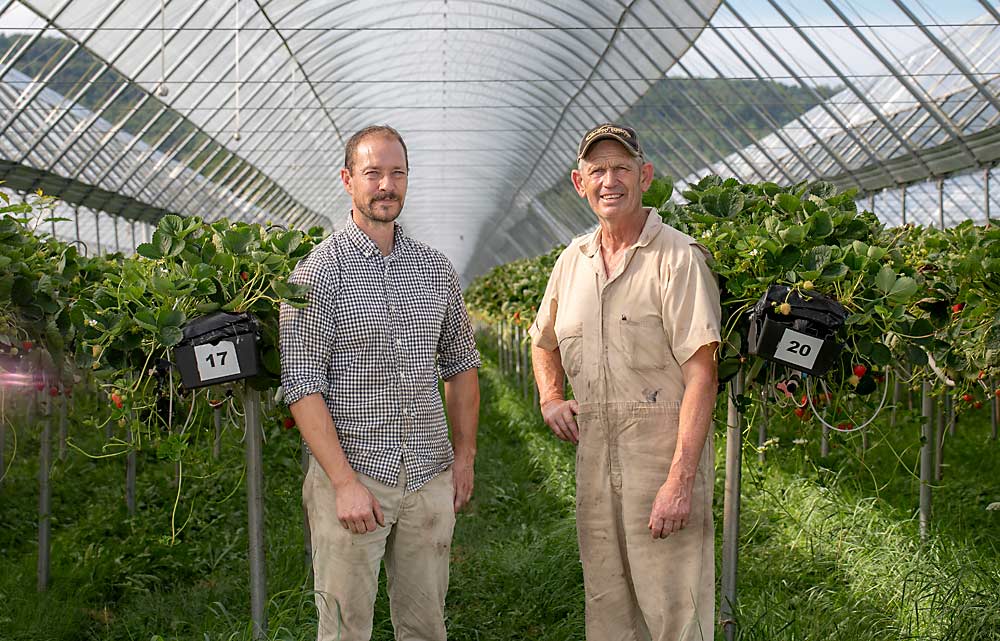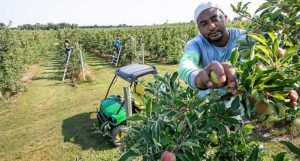
Apples pose a labor challenge for many growers, but one diversified Canadian farm sees the labor-intensive orchard crop as an advantage, giving their workers more hours.
Located in Canning, Nova Scotia, Vermeulen Farms grows a wide variety of produce and commodity crops on 450 acres, including asparagus, lettuce, peppers, cucumbers, zucchini, squash, cut flowers and strawberries. They plan to add apples to stretch the season even more, said Ben Vermeulen, who co-owns the farm with his father, Andy.
In July, the International Fruit Tree Association visited Vermeulen Farms, where Ben and Andy discussed some of their experiences with Canada’s Seasonal Agricultural Worker Program, SAWP. The Vermeulens are so reliant on offshore workers hired through the program that they’ve oriented their entire crop mix and acreage around getting those workers enough hours and a lengthy contract — all to entice them to return year after year.
“If they can make a decent living here, it gives them a reason to come back,” Ben said. “We’ve had guys coming back for 20 years. They get off the plane and know exactly what to do.”
Offshore workers can stay in Canada up to eight months per year. The Vermeulens want their workers to earn a year’s wages within that period. The goal is to get them close to 2,000 hours for the season, Andy said.
“We set the program up to fit the labor,” he said. “If they’re coming here for eight weeks just to pick apples, they’re not getting enough hours.”
When they started growing produce in the late 1980s, the Vermeulens relied on student workers. But turnover was constant, with students going back to school or on vacation in September — a busy harvest month. It wasn’t long before they started hiring foreign workers through SAWP. They now have 73 Mexicans and Guatemalans working on the farm at peak season.
Offseason work is done by Andy and Ben, Ben’s wife, Lindsey, and three local, full-time workers. In early spring, they start strawberry mother plants and lettuce plants in the greenhouse. The first offshore workers show up in early April. Their first task is planting strawberries in the tunnels, which takes two or three weeks.
The Vermeulens stagger their crop harvests and try to match crop acreages with their number of laborers. Asparagus harvest, and their cash flow for the year, starts around May 10, by which time all of their offshore workers have arrived. Strawberry harvest starts in June and continues through October (under the plastic tunnels). From June through September, lettuce, zucchini, cucumber, pepper and squash harvests come online, all timed to spread out the workload.
The Vermeulens currently rent about 10 acres of apple orchards to give their employees harvest work in late September and October. They also allow them to pick apples on other farms. Different farms can share SAWP workers to a degree, but there are detailed rules they must follow, Andy said.
They contract crews from other farms to prune and perform other management tasks on their rented orchard land. They plan to plant up to 25 acres of their own apples in 2025, however, and when those trees are ready, they’ll probably dedicate two or three of their own workers to the preharvest management tasks, Andy said.
Employers are not required to pay farmworkers, including those hired through SAWP, overtime, but they must give them one day off per week. The Vermeulens typically give their workers Sundays off, Ben said.
During the summer, one crew might harvest lettuce in the morning, then cucumbers and peppers in the afternoon, and spend the evening in the packing house. There’s some overlap between crews, but strawberry crews are usually always in the strawberries, harvesting berries or maintaining plants. During particularly busy periods in August and September, nonharvest tasks such as weed control tend to suffer, Ben said.
The greenhouses and tunnels that cover some of their crops also offer labor flexibility: If it’s raining, the crews spend more time doing tasks under the covers.
By the end of October, the farm fields are cleaned out and most of the workers start flying home. If workers have the time and inclination to stay after the busy season, the Vermeulens try to find work for them, whether it’s picking apples or harvesting Christmas trees for other farms. In November and December, their local and remaining offshore workers will do off-season work such as construction projects, preparing equipment and packing strawberry plants grown in the nursery, Ben said.
“It’s better the guys be too busy than not busy enough,” he said. “The labor part works out much better when there’s lots of work to do.”
—by Matt Milkovich







Leave A Comment